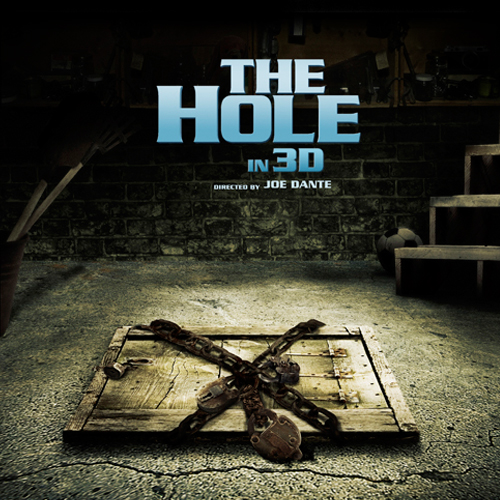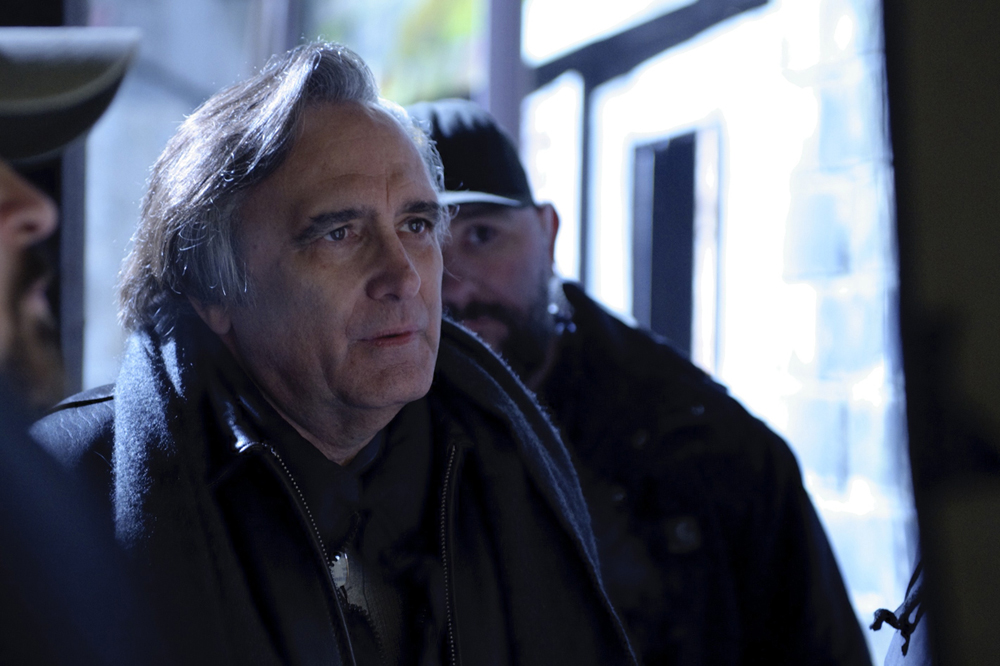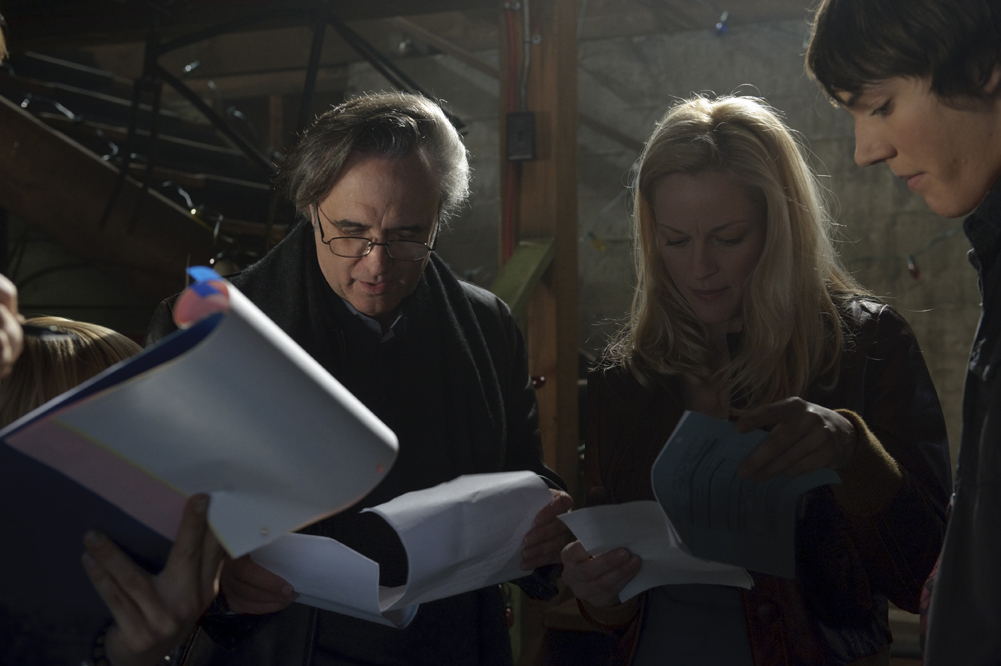I have a fourteen year old niece.
Like me – like a lot of us – she grew up with the films of Joe Dante. Recently, the two of us sat down to the watch the esteemed filmmaker’s latest – The Hole, which opens Friday in a limited 3D engagement before making its way to VOD Platforms and home video on October 2nd.
The tale of brothers Dane and Lucas (Chris Massoglia and Nathan Gamble) transplanted to small-town America by their caring yet obviously wounded mom (Teri Polo) and forced to confront a primordial evil dwelling beneath their feet, The Hole is a high-tech take on the old-school chills-and-thrills picture Hollywood doesn’t really understand how to make anymore. Dante does. He’s made a career out of smuggling sobering subtext, irreverent humor, and refreshing earnestness into the wildest of rides, and he reminds us of his gift for that sort of thing with this film.
When I got the assignment to talk to him, I told Dante that my niece wanted to watch the film again immediately after we finished it.
He laughs. “That’s always a good sign!”
And you know, her grandparents do the whole, “Are you sure you should show her the scary movie?” thing – and I say, “We can trust in Joe Dante” – ‘cause you’ve always been able to walk the line between –
“It is a line, too.” Dante says with regard to the intuitive manner in which he has always been able to get to the core of what makes our hearts race without spraying us with gore and offal. “The producers say are saying ‘Do we want a PG or a PG 13?’ And I say, ‘Well you don’t want a PG, because nobody over ten years old is going to want to see it – but you don’t want an R, because people won’t let their kids see it. So we managed to get a PG-13.”
Dante is, of course, along with Steven Spielberg, the impetus for the PG-13 rating in the first place. The duo’s original Gremlins confused the MPAA and freaked out parents who thought they were taking their tots to see a quirky little comedy with chattering creatures. Even within Dante’s most fantastical films, there are real-world consequences – Chip Hazard and the Soldier Elite are shooting saw blades at people’s heads. The threat is real. The peril is present – and yet…“we managed to get a PG-13.”
“But it is a tightrope walk, because you’ve got a movie like this – which appealed to me because, when I read the script, I like the writing and I liked the characters – but what really appealed to me was that it didn’t go where I thought it was gonna’ go. And considering that it goes into a darker and somewhat more personal area by the end, the question was: how much of what happened in this dysfunctional family do we really wanna’ know? I personally took it that a lot of really bad things happened to these kids – and it’s stuff that we really don’t want to detail. And the audience can think about it – or not think about it – as much as they want.”
It’s hard not to think about it. The characters are likeable and authentic, and the fear – at least for some of them – is rooted less in “boo” and more in what lives inside of them. If there is a psychological terror at work in the film, it’s fear of miserable failure – and probably shame.
“The important thing,” Dante explains, “was not to scare the kids with that – especially when you have other things to scare the kids which are much more immediate. You don’t want them going home thinking about what would happen if Daddy touched me inappropriately…”
Dante has always had a knack for creating honest, believable portrayals of young people – whether with Explorers or Small Soldiers or Eerie, Indiana – the otherworldly/supernatural shenanigans are always grounded by kids you feel like you know or knew – or were. The kids in The Hole are no exception. Massoglia, Gamble, and girl-next-door Haley Bennett are engaging and intelligent and often really funny – but they’re also brutally believable as kids who have suffered through some fairly horrific shit before they ever found a magic subterranean gateway to what terrifies them. I wonder how it is that Dante has been able to consistently craft compelling young characters when so many filmmakers flounder in that regard.
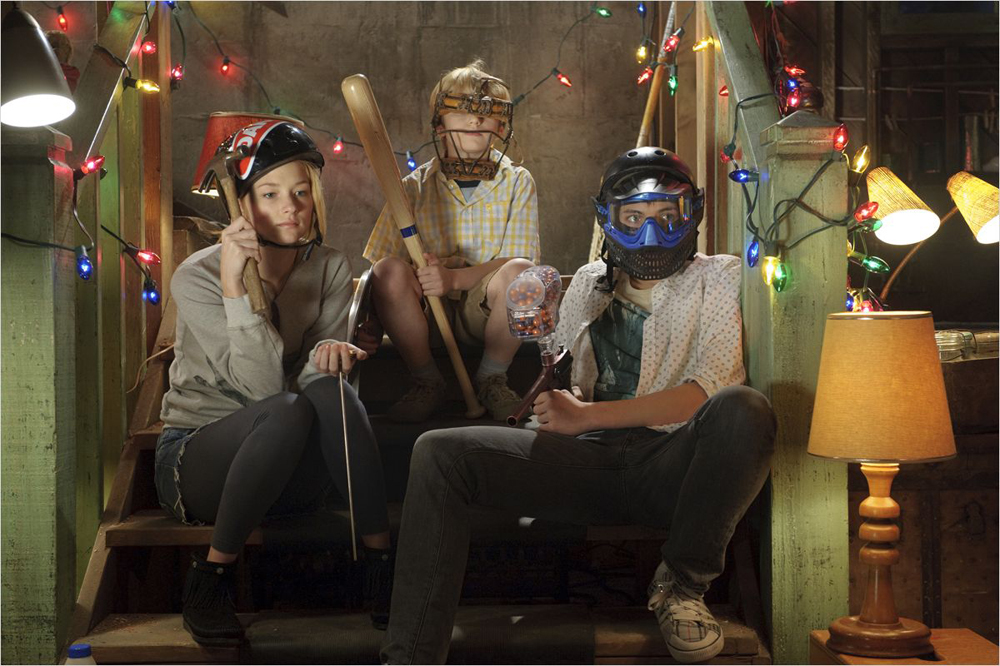
Dante creates very real kids. I know this is the kinda’ stuff I was up to when I was sixteen. Or last week…
“Well, they say filmmakers are just big kids – which is certainly true if you watch the way some of them comport themselves – but the whole thing with kids is it’s just about casting the right ones. And we’ve all seen the squeaky-clean Disney kids who’ve been taught to be cute – and who can’t hold the screen for three minutes before you just say, ‘I can’t stand them.’ So trying to find kids who are themselves – and have real personalities you actually can use is the trick.”
The dynamic between the brothers is very real, and often quite unkind. The elder Dane sometimes seems on the cusp of bullying little Lucas – who is, for his part, willing to comically wind his big brother up.
“The relationship between the two brothers is very acrimonious – which I think is the way it is in families – it certainly was true between me and my brother. And Chris’s character actually risks being unsympathetic because he’s so angry and sullen and inside himself – but later we find that he has a good reason for the way he acts.”
I tell Dante that Dane’s mean-spiritedness feels very much built-in as a means to allude to the trauma of his childhood – and to foreshadow what’s coming for him.
“I think so. We also gave him a reason to act that way – the first thing his little brother does is hit him in the head with a basketball!“
“He’s definitely willing to push big brother’s buttons.”
“And I mean – that’s the way I looked at my little brother! As far as I was concerned, that’s all he was doing. I had had a friend of mine over from school once – he was the son of my art teacher – and my brother hit him in the groin with a baseball bat…so my art grade went down for the whole year.”
And yet Dane’s response to his brother’s antagonism – which is obviously just a plea for attention from a person he clearly looks up to – is tinged with a cruelty we come to understand is fueled by the residual pain of a very rough childhood. Dane’s arc is very literally a stare into the abyss/let the abyss stare into you proposition. The hole Dante has dug may seem to bring fear to life – but what emerges is, thematically, far more terrifying than any boogeyman.
“And if you don’t conquer your fears,” Dante says, “you end up like Bruce Dern’s character – where he’s just completely hiding from the world. That was presented to the kids as the possibility of what they could become if they don‘t do something about it.”
The extraordinary Bruce Dern – who worked so memorably with Dante in his cult fave The ‘Burbs (“I was eighteen months in the bush and I could snap your neck in a heartbeat!”) – is cast here as rattled recluse Creepy Carl, who discovered the hole decades earlier…and cracked like a piñata for his efforts. Something of a local legend, the kids track him down hoping that he can help them shut the doorway to the depths they’ve accidentally opened. Dern, as ever, serves up pretty great support.
So yeah – The Hole is the Dark Night of the Soul, a wisecracking comedy, a spook story and a fractured coming of age tale, wherein a young man discovers and confronts the nightmare part of himself while his fractured family hangs in the balance. Will he embrace and replay the cruelty of his past, or can he step out from under it?
That all might sound very pretentious – and in the hands of another filmmaker, it very well could be – but Dante is content to let these elements color the drama, but never overpower it. This is, in some ways, quintessential Dante – the notions of broken family/failed suburbia run through so many of his films – but this might be the first time that family unit has torn itself apart. In promotional materials for the film, actress Polo says that she was drawn to her character because she was not a typical perfect movie mother, and that’s the kind of somber subtext that creeps through the film. Despite thrilling set pieces and some real hilarity, there is a sinister darkness to the film that little in Dante’s filmography touches.
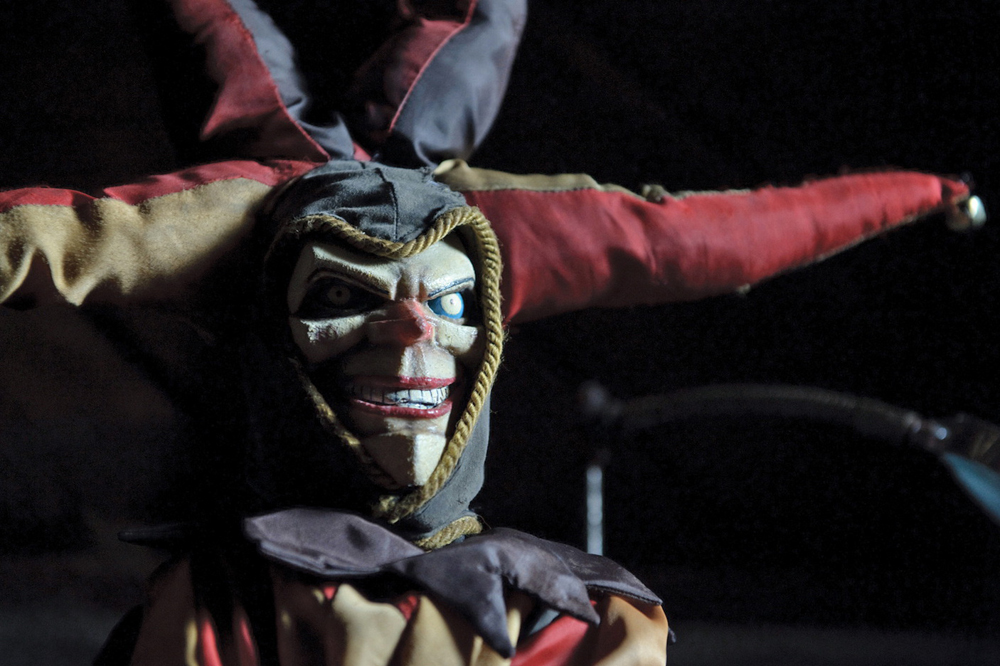
And yet, for all my pretentious “ohhh…the fear is internal…oooh” – there’s THIS little bastard, who I hate immensely.
“Except maybe (his Masters of Horror episode) The Screwfly Solution,” I offer.
Dante chuckles. “Yeah, I don’t think many things are as grim as The Screwfly Solution. I can imagine people jumping off bridges after watching The Screwfly Solution.” You can hear the sinister glee in his voice.
“And at the same time,” I say, “the overarching message of the film is, of course, that the darkness inside us can be overcome.”
Dante agrees and adds, “And I think if we didn’t make that statement, it would be one really depressing film.”
For me, Dante’s finest film is Matinee – a sort of American Graffiti for cinephiles that I’ve always felt trumps Lucas’s Boomer time capsule because of Dante’s knack for timelessly relatable characters (I’ve never cared about anyone in Graffiti – though as a child, I often wondered why Han Solo was wearing that stupid hat). Dante’s film is less worried about custom cars, Wolfman Jack, and needle drops, and far more interested in creating a charming tale of youth and the movies – represented in larger-than-life fashion by John Goodman’s Lawrence Woolsey, a Roger Corman-by-way-of-William Castle filmmaker/showman/huckster who blows into town with his latest creature feature amid worrisome Cold War saber-rattling in order to put the film‘s lead on the road of life. Woolsey is a character crafted to indulge Dante’s obvious love of cinematic history – or at least cinematic gimmickry in the Emergo/Percepto vein. That love is why 3D becomes such a perfect fit for him – Dante understands the technology on both an atmospheric and gimmicky level – as a student of film history and a buff.
I asked if shooting The Hole in 3D was something the producers wanted, something that was written into the script from the start, or something he himself had hoped to do. I already knew the answer.
“It was actually my idea. I told the producers that this particular movie could be enhanced by 3D because it was basically a small film – it didn’t have a lot of locations or a big cast. And since so much of it takes place in a basement – you don’t want the audience to get claustrophobic – you want them to be enveloped by this. If this is a scary basement with fear all around, you want that fear to be all around the theater – and the best way to do that is to make them feel like they’re in the picture.
So most of the 3D is not the ‘throwing things out of the screen’ 3D – it’s a “drawing you into the picture kind of feel.”
“Did the 3D boom of the ’50s color your desire to shoot a 3D film?”
“I had done a 3D film already for Busch Gardens – a ride film called R.L. Stine’s Haunted Lighthouse. And they call that “4D” because it’s not just in 3D with the glasses – they drop water on you and make it feel like rats are crawling up your pants and all that kinda‘ stuff…so I had some familiarity with 3D – and of course I’m old enough to have seen all of those ‘50s 3D movies when they were new. I’ve always loved 3D – and I think that it is a legitimate storytelling tool. I don’t think every picture should be in 3D, but I do think if you craft a 3D movie and plan it as a 3D movie – as I understand the new Resident Evil movie has been approached – that you can really get the most out of it. You can really make it work for you. I don’t know if you’ve seen the film in 3D…”
“Unfortunately, I haven’t – though I do have a 3D television…”
“You do? Wow – you mean with the shutter glasses?”
Yeah – the active tech. I don’t think the passive is there quite yet.”
“You can get the film on 3D Blu Ray from Italy, I think.”
“I looked into that, but I’m region locked at the moment.” I tell him. “I was kinda’ hoping this video release would be in 3D…”
“I’m a little surprised that it wasn’t,” Dante laments. “I think they must have just decided there aren’t enough TV’s to justify it yet.”
“It’s getting better, I think. I’ve started seeing titles drop in price to around the $15.00 mark, so it’s possible we’ll start seeing it get more accessible. And I’m so psyched because they’re starting to release catalog titles now.” I inform him that Dial “M” for Murder comes out next month.
“And that’s always been my model for 3D – because it’s basically a stage play. And I’d seen it in 2D for years – and you know, it’s a Hitchcock movie – of course I loved it. But when I saw it in 3D it was a different movie.”
“Did the technology add any time to your shooting schedule overall?”
“Quite oddly, it didn‘t. We did a lot of tests beforehand, and we obviously checked lenses – there are certain kinds of lenses are better for 3D and certain lenses that aren’t. You shoot the picture and you have a stereographer on set, and you can tell him where you think things should be in the frame – but you have the ability to modify that later. So you eventually go through the movie and make sure that every cut doesn’t displace the audience. Sometimes you tone down the beginning of a shot and bring up the 3D, and just before the cut you bring it down again – it’s almost like conducting.”
“I wonder – having not seen it in 3D…and knowing that you have the ability to tweak the impact of the 3D over the course of a single shot. I just sit back and imagine the finale, where Dane descends into the hole, and everything becomes this forced perspective nightmare – did you have fun manipulating that in post?”
“We did – and I did some experiments that didn’t work with…reversing the 3D.”
“Oh wow! That’s so wild!”
“But you know – it gave me a headache, and so I thought we’d better not do that…”
The Hole is great fun and thrills and pain and boo and creep – it’s everything you’ve grown to love about a filmmaker as smart as Joe Dante is. Go check out The Hole at www.theholein3d.com, Like the film on Facebook, and visit with Joe at his wonderful TrailersFromHell.com.
Thank you to Mr. Joe Dante, and to Ms. Jill Richey at the Richey Group. The Hole is being released by Big Air Studios.
